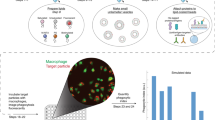Abstract
MACROPHAGES interact with other cells and components of the extracellular environment by means of adhesion receptors1,2. Adhesion to artificial substrata in vitro facilitates isolation of macrophages3, and has been used to generate antibodies that inhibit their migration in vivo4,5. Unlike other cell types, macrophages attach to tissue culture plastic in the absence of divalent cations. Here we use an adhesion assay exploiting this property to isolate a rat monoclonal antibody, 2F8, which totally inhibits divalent cation-independent adhesion of murine macrophages to tissue culture plastic in the presence of fetal calf serum. Immunoprecipitation from macrophages and stably transfected Chinese hamster ovary cells revealed that the antigen recognized by monoclonal 2F8 is identical to murine macrophage scavenger receptor6,7. We propose a novel function for this molecule, previously described as an endocytic receptor, thus providing a mechanism for mononuclear phagocyte recruitment to and retention in ligand-rich tissues such as in atherosclerotic lesions.
This is a preview of subscription content, access via your institution
Access options
Subscribe to this journal
Receive 51 print issues and online access
$199.00 per year
only $3.90 per issue
Buy this article
- Purchase on Springer Link
- Instant access to full article PDF
Prices may be subject to local taxes which are calculated during checkout
Similar content being viewed by others
References
Pearlstein, E., Dienstman, S. R. & Defendi, V. J. Cell Biol. 79, 263–267 (1978).
Springer, T. A. & Anderson, D. C. Ciba Found. Symp, 118, 102–126 (1986).
Johnson, W. D. Jr Mei, B. & Cohn, Z. A. J. exp. Med. 146, 1613–1626 (1977).
Rosen, H. & Gordon, S. J. exp. Med. 166, 1685–1701 (1987).
Rosen, H., Gordon, S. & North, R. J. J. exp. Med. 170, 27–37 (1989).
Krieger, M. Trends biochem. Sci. 17, 141–146 (1992).
Freeman, M. et al. Proc. natn. Acad. Sci. U.S.A. 87, 8810–8814 (1990).
Hynes, R. O. Cell 69, 11–25 (1992).
Bevilacqua, M. et al. Cell 67, 233 (1991).
Springer, T. A. Nature 346, 425–434 (1990).
Leenen, P. J. M., Jansen, A. M. A. C. & van Ewijk, W. Differentiation 32, 157–164 (1986).
Raschke, W. C., Baird, S., Ralph, P. & Nakoinz, I. Cell 15, 261–267 (1978).
Galfre, G., Milstein, C. & Wright, B. Nature 277, 131–133 (1979).
Penman, M. et al. J. biol. Chem. 266, 23985–23993 (1991).
Ashkenas, J. et al. J. Lipid Res. 34, 983–1000 (1993).
Davis, G. E. Expl Cell Res. 200, 242–252 (1992).
Quinn, M. T., Parthasarathy, S., Fong, L. G. & Steinberg, D. Proc. natn. Acad. Sci. U.S.A. 84, 2995–2998 (1987).
Hale, G. et al. J. immun. Meth. 103, 59–67 (1987).
Goding, J. W. in Handbook of Experimental Immunology (eds Weir, D. M.) 20.1–20.33 (Blackwell Scientific, Oxford, 1986).
Laemmli, U.K. Nature 227, 680–681 (1970).
Geng, Y.-j. & Hansson, G. K. J. clin. Invest. 89, 1322–1330 (1992).
Pitas, R. E., Innerarity, T. L., Weinstein, J. N. & Mahley, R.W. Arteriosclerosis 1, 177–185 (1981).
Rabinovitch, M. & de Stefano, M. J. J. exp. Med. 143, 290–304 (1976).
Author information
Authors and Affiliations
Rights and permissions
About this article
Cite this article
Fraser, I., Hughes, D. & Gordon, S. Divalent cation-independent macrophage adhesion inhibited by monoclonal antibody to murine scavenger receptor. Nature 364, 343–346 (1993). https://doi.org/10.1038/364343a0
Received:
Accepted:
Issue Date:
DOI: https://doi.org/10.1038/364343a0
This article is cited by
-
The physiology of foamy phagocytes in multiple sclerosis
Acta Neuropathologica Communications (2018)
-
Current Concepts of the Role of Oxidized LDL Receptors in Atherosclerosis
Current Atherosclerosis Reports (2012)
-
SR-A ligand and M-CSF dynamically regulate SR-A expression and function in primary macrophages via p38 MAPK activation
BMC Immunology (2011)
-
Modified low density lipoproteins binding requires a lysine cluster region in the murine macrophage scavenger receptor class A type II
Molecular Biology Reports (2010)
-
Protective Effect of Comaruman, a Pectin of Cinquefoil Comarum palustre L., on Acetic Acid-Induced Colitis in Mice
Digestive Diseases and Sciences (2006)
Comments
By submitting a comment you agree to abide by our Terms and Community Guidelines. If you find something abusive or that does not comply with our terms or guidelines please flag it as inappropriate.



